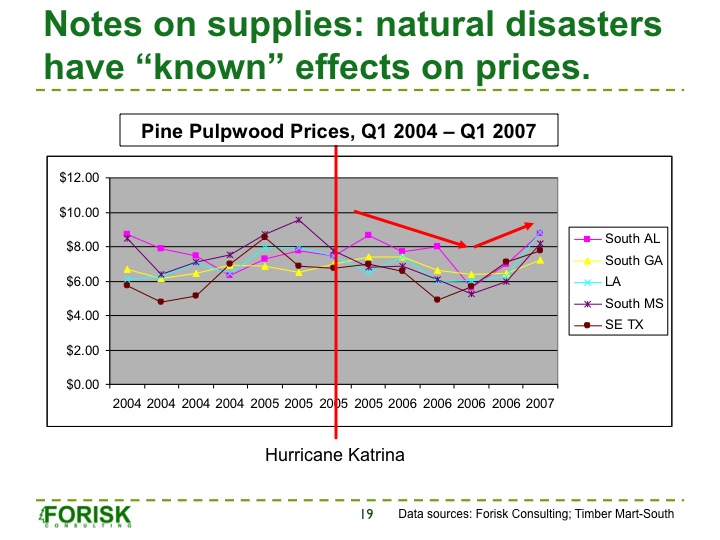Shawn Baker, Andrew Copley and Justin Tyson contributed to this blog.
Catastrophic or severe weather events and risks may exceed the abilities and flexibility of the most talented wood supply organization. How might we think about these risks? Weather risk is “volumetric” risk, representing the potential impacts on earnings and cash flow from changes in volume. Catastrophic weather events, such as hurricanes and floods, can halt normal business activities, while simultaneously (and ironically) creating a demand for building products needed to repair and rebuild homes and businesses.
The recent, destructive flooding and weather events centered in Texas and Florida remind us that Mother Nature is a force to be reckoned with. Combined, the two storms killed over 150 people. According to the Texas Department of Emergency Management, Hurricane Harvey damaged or destroyed 150,000 homes in Texas. Estimates remain underway in Florida and Georgia on the impact of Hurricane Irma. Notwithstanding the trauma these storms visited on the victims, the effects on communities and local economies sting and endure.
Hurricanes can have significant localized effects on timber markets. These effects include, one, the interruption of current forest operations and manufacturing and, two, the disruption of current and future harvest plans through affecting timber supplies. The direct effect on timber stands is still being estimated for Irma, while Harvey appears to have primarily affected operations through the drenching rains dropped in east Texas and Louisiana. How can history help us understand the potential impacts of these recent disasters?
In 2004, seven hurricanes – including Bonnie, Charley, Gaston and Ivan – landed in a period of less than two months inflicting damages of approximately $1 billion. In 2005, twelve hurricanes – including Katrina and Rita – pummeled the South. Hurricane Katrina hit at the Mississippi-Louisiana border in August 2005 and ultimately destroyed about 275,000 homes. The estimated direct and indirect costs to the forest products industry of Katrina, including higher harvesting costs, lost production and inventory, approached $12 billion. Base case estimates as of 2007 put the timber specific impact from Katrina at $1.7 billion in sawtimber and $153 million in pulpwood losses.
Previous research informs us how major weather events can affect timber prices. US Forest Service researchers Prestemon and Holmes (1997) compared stumpage prices before and after Hurricane Hugo in 1989, concluding that, depending on the event size, there will be an initial decline in timber prices as short-term supplies increase from blow-down and damaged timber. Sawtimber prices recovered to pre-Hugo prices within seven quarters after the storm, while pulpwood prices remained depressed by 35%. Further research by Yin and Newman (1999) on how Hugo affected the timber supplied confirmed the initial analysis by Prestemon and Holmes. In sum, this research indicates that prices fall in the short-term and recover in the long-term.
Following Hurricane Katrina, pulpwood price trends followed those predicted by the previous research (Figure). Pulpwood prices in South Mississippi and Louisiana declined immediately following Katrina, while all of the Southern markets declined as a group during the year following Katrina. Then, as a group, pulpwood prices recovered in late 2006 and early 2007. While a portion of these changes may be attributable to Katrina, they also reflect cyclical trends in the end product markets for pulp.

That said, natural disasters do not occur in economic vacuums. Mother Nature does not have a 401K or invest with hedge funds, but her actions affect markets differently depending on what else is happening in the economy. While we talked to local effects, the relative impacts vary if disasters hit during an economic expansion or recovery versus a recession. In Part II, we address relative expectations and unanswered questions for housing markets and forest product demand given where we are today.
Forisk will teach “Wood Flows & Cash Flows” in Atlanta on December 7th, a one-day event that reviews and applies research and analysis to investments and forecasts across the forest industry supply chain, from timberlands to mills owned privately and by publicly traded firms.

Leave a Reply